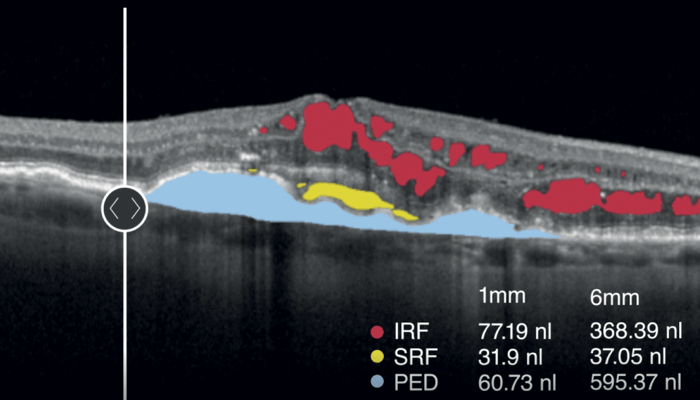
Diagnosing neovascular AMD (nAMD) depends on careful interpretation of OCT imaging and close retinal fluid monitoring. Yet these criteria rely on doctors’ clinical opinions that can lead to inefficiency in practice for both physicians and patients. A new AI-based measurement tool now has the potential to transform disease monitoring, revealing new insights into how retinal fluid acts as a vital biomarker for tracking nAMD progression. We sat down with Ursula Schmidt-Erfurth, a worldleading expert on ophthalmic imaging, to talk about how AI technologies can be brought to bear on this issue, thanks to the newest application developed by the team at RetInSight, a company providing AI-based clinical decision support.
In the context of managing retinal conditions, how important would you say retinal fluid is?
Fluid is the major biomarker in macular disease management. It is a vital diagnostic feature, and is particularly important as the most frequently used therapy is anti-VEGF therapy. This means injections of substances into the human eye and what anti-VEGF therapy does is target fluid. The scale of the problem is vast: we have 200,000,000 people worldwide affected by AMD. That means eye care professionals are performing 20,000,000 intravitreal injections per year and producing 50,000,000 OCT scans!
In a nutshell, how does the RetInSight Fluid Monitor work?
It is a precision tool that measures fluid based on pixels in real time. The monitor integrates the 3D and high-resolution components of OCT images. The image is uploaded to the cloud, where every image point is analyzed and the result is sent back to the user. The report offers all relevant features at a glance: where the fluid is, fluid volume and the course of disease activity over time. It’s a precise activity meter that turns fluid volumes into nanoliters in a reliable and objective manner, it can be used in real-time anywhere an OCT is located and substantially reduces the time spent on searching for changes over follow-up.
Some retina specialists may have preconceived notions about the reliability of automated algorithms. What would you say to skeptics?
There is always debate when new technology emerges. The fluid monitor empowers physicians by functioning as a measurement tool for decision-making. After all, trustworthiness comes with every quantitative tool, from glucose measurements in diabetes to blood pressure tracking for hypertension care. In the retina clinic we are not looking at a single OCT scan, but have to assess three compartments of fluid in a three-dimensional data set. Any tool that can capture precision in 3D volumes is more trustworthy than a human expert’s effort to deal with 3D scans containing millions of pixels. From this data we can develop new guidelines and finally have true fluid-guided measurement that takes into account fluid dynamics across all the different compartments of the retina.
What is your main message to retina specialists about fluid monitoring?
Empower yourself! Use the new technology to gain better control on disease activity and therapeutic responses. Take an active role in making retina care accurate and efficient. Learn from your data, improve your own technique based on objective quantitative parameters, and help develop new, community-approved, evidence-based management guidelines that come from the real world, not from clinical study protocols.
AI tools are not luxuries; they are badly needed in retinal medicine. Over the recent years, WHO statistics indicate that vision loss has increased by 24 percent. (1) We have excellent diagnostic tools, we need ways to make sense of the wealth of imaging information – and that is what AI is doing, both clinically and economically. After all, US$8 billion is spent each year on anti-VEGF therapy, (2) so it’s our job to make sure we use these large resources as efficiently as possible and in the best interests of our patients.
What is the role of companies like RetInSight in supporting ophthalmologists in these developments that you described?
RetInSight’s role as a technology provider is to make sure that the system is reliable and user-friendly – vital features as we are talking about a huge effort in daily care in clinical practice. The Fluid Monitor has to be fast and responsive to physician’s needs. The feedback from the first launch users – the next generation of technology-competent physicians – is most relevant for a daily care tool such as the FM to become a democratic facilitator in the hands of physicians.
References
- T. Vos et al., “A systematic analysis for the Global Burden of Disease’ Lancet, (2016).
- B. Syed et al., “Wet AMD market.” Nature Reviews Drug Discovery 11, (2012).
